Overview of moxibustion treatment and acupuncture points!
Moxibustion recipes (with acupuncture point diagrams), the 30 most important moxibustion points on the body.
High-definition meridian circulation diagrams, a complete guide to human acupuncture points!
Properly pairing acupuncture points; increases pain relief effectiveness by 10 times! (Most comprehensive collection)
Moxibustion plans for nine different body constitutions (very comprehensive).
Incredible moxibustion cases from historical records, worth reading!
Overview of moxibustion pairing.
While moxibustion is beneficial, it should not be done blindly; a comprehensive dissemination of moxibustion knowledge! (Collection)
The most comprehensive moxibustion disease response guide, a must-collect for moxibustion enthusiasts!
★TCM Learning (Massage, Moxibustion, Gua Sha) Video Collection
Moxibustion therapy is rich in content and diverse in types, which can be broadly categorized into four major types: namely, moxa cone moxibustion, moxa stick moxibustion, warm needle moxibustion, and warming moxibustion device. Each category contains many specific methods, which will be introduced one by one.Moxa Cone MoxibustionMoxa cone moxibustion refers to the method of rolling pure moxa wool into cones of varying sizes, placing them on the treatment area, and igniting them for moxibustion. Commonly used moxa cones are categorized into small, medium, and large, where small moxa cones are about the size of a grain of wheat, medium ones are about the size of a lotus seed, and large ones are about the size of half an olive.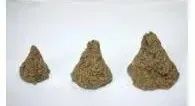 Each time a moxa cone is burned is referred to as one “zhuang”, and the number of moxa cones used during treatment should depend on the patient’s specific condition. Moxa cone moxibustion can be divided into direct moxibustion and indirect moxibustion.(1) Direct Moxibustion: Direct moxibustion involves placing a suitably sized moxa cone directly on the skin for treatment. This method is further divided into two types: scar moxibustion (also known as suppurative moxibustion) and non-scar moxibustion (non-suppurative moxibustion).① Scar Moxibustion (Suppurative Moxibustion): Before treatment, a small amount of garlic juice is applied to the treatment area to enhance adhesion and stimulation (for patients with sensitive skin, a small amount of water or vegetable juice can be used instead). Then, a suitably sized moxa cone is ignited and placed on the skin at the treatment site until it burns out. The goal is to cause a burn at the moxibustion site, leading to suppuration and the formation of a moxibustion sore, which heals naturally, leaving a scar.This method is quite painful and is mainly used for treating chronic stubborn diseases; it is rarely applied to other conditions.② Non-Scar Moxibustion (Non-Suppurative Moxibustion): Before moxibustion, a small amount of petroleum jelly is applied to the treatment area, and then a lit small moxa cone is placed on the skin. When a burning sensation is felt, the moxa cone is removed with tweezers, and a new cone is used until the local skin shows redness without blistering.This method is mainly used for treating deficiency-cold conditions, is easier to accept, and is more commonly used.(2) Indirect Moxibustion (Moxibustion with Intermediary): Indirect moxibustion involves placing certain items (i.e., using a medium) between the moxa cone and the skin before performing moxibustion. Depending on the intermediary used, the following common methods are available.① Ginger Moxibustion: Fresh ginger is sliced into approximately 0.3 cm thick pieces, with several holes poked in the center, placed on the treatment area, and a lit moxa cone is placed on the ginger slice for moxibustion. When the moxa cone burns out, a new cone is used until the skin shows redness without blistering.This method disperses cold and alleviates pain, warms the stomach, and stops vomiting, mainly used for treating wind-cold bi pain, vomiting, abdominal pain caused by cold, etc.
Each time a moxa cone is burned is referred to as one “zhuang”, and the number of moxa cones used during treatment should depend on the patient’s specific condition. Moxa cone moxibustion can be divided into direct moxibustion and indirect moxibustion.(1) Direct Moxibustion: Direct moxibustion involves placing a suitably sized moxa cone directly on the skin for treatment. This method is further divided into two types: scar moxibustion (also known as suppurative moxibustion) and non-scar moxibustion (non-suppurative moxibustion).① Scar Moxibustion (Suppurative Moxibustion): Before treatment, a small amount of garlic juice is applied to the treatment area to enhance adhesion and stimulation (for patients with sensitive skin, a small amount of water or vegetable juice can be used instead). Then, a suitably sized moxa cone is ignited and placed on the skin at the treatment site until it burns out. The goal is to cause a burn at the moxibustion site, leading to suppuration and the formation of a moxibustion sore, which heals naturally, leaving a scar.This method is quite painful and is mainly used for treating chronic stubborn diseases; it is rarely applied to other conditions.② Non-Scar Moxibustion (Non-Suppurative Moxibustion): Before moxibustion, a small amount of petroleum jelly is applied to the treatment area, and then a lit small moxa cone is placed on the skin. When a burning sensation is felt, the moxa cone is removed with tweezers, and a new cone is used until the local skin shows redness without blistering.This method is mainly used for treating deficiency-cold conditions, is easier to accept, and is more commonly used.(2) Indirect Moxibustion (Moxibustion with Intermediary): Indirect moxibustion involves placing certain items (i.e., using a medium) between the moxa cone and the skin before performing moxibustion. Depending on the intermediary used, the following common methods are available.① Ginger Moxibustion: Fresh ginger is sliced into approximately 0.3 cm thick pieces, with several holes poked in the center, placed on the treatment area, and a lit moxa cone is placed on the ginger slice for moxibustion. When the moxa cone burns out, a new cone is used until the skin shows redness without blistering.This method disperses cold and alleviates pain, warms the stomach, and stops vomiting, mainly used for treating wind-cold bi pain, vomiting, abdominal pain caused by cold, etc.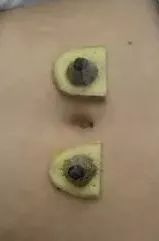 ② Garlic Moxibustion: Fresh garlic is crushed into garlic paste, made into a cake about 0.3 cm thick, or a single clove of garlic is sliced into pieces about 0.3 cm thick and placed on the acupuncture point skin, with other operations similar to ginger moxibustion.This method clears heat and detoxifies, kills parasites, and alleviates itching, mainly used for treating carbuncles, swellings, etc.
② Garlic Moxibustion: Fresh garlic is crushed into garlic paste, made into a cake about 0.3 cm thick, or a single clove of garlic is sliced into pieces about 0.3 cm thick and placed on the acupuncture point skin, with other operations similar to ginger moxibustion.This method clears heat and detoxifies, kills parasites, and alleviates itching, mainly used for treating carbuncles, swellings, etc.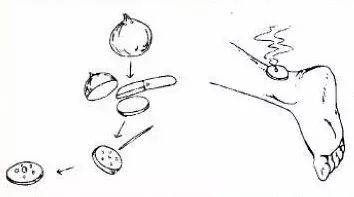 ③ Salt Moxibustion: Dry salt is placed on the navel (or a thin slice of ginger is placed on the salt to prevent the salt from exploding when heated), and then a large moxa cone is placed on top for moxibustion.This method revives yang and rescues from collapse, mainly used for treating acute vomiting and diarrhea, abdominal pain, and collapse.④ Fuzi Cake Moxibustion: Fuzi is ground into powder, mixed with alcohol to form a cake the size of a coin, with several holes poked in the center, placed on the treatment area, and then a lit moxa cone is placed on top for moxibustion.This method warms the kidneys and tonifies yang, mainly used for treating impotence, premature ejaculation, and chronic non-healing sores caused by kidney yang deficiency.
③ Salt Moxibustion: Dry salt is placed on the navel (or a thin slice of ginger is placed on the salt to prevent the salt from exploding when heated), and then a large moxa cone is placed on top for moxibustion.This method revives yang and rescues from collapse, mainly used for treating acute vomiting and diarrhea, abdominal pain, and collapse.④ Fuzi Cake Moxibustion: Fuzi is ground into powder, mixed with alcohol to form a cake the size of a coin, with several holes poked in the center, placed on the treatment area, and then a lit moxa cone is placed on top for moxibustion.This method warms the kidneys and tonifies yang, mainly used for treating impotence, premature ejaculation, and chronic non-healing sores caused by kidney yang deficiency.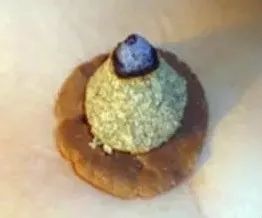 Moxa Stick MoxibustionMoxa stick moxibustion is a method of moxibustion using moxa sticks made from moxa wool. Moxa sticks are made by wrapping moxa wool in cotton paper or mulberry paper into long strips, with those containing no medicinal powder referred to as pure moxa sticks, and those mixed with certain herbal powders referred to as medicinal moxa sticks. Currently, smokeless moxa sticks are also available on the market. Regardless of the type of moxa stick used, the methods of moxa stick moxibustion mainly include the following three types.(1) Gentle Moxibustion: During moxibustion, one end of the moxa stick is ignited and held about 2-3 cm away from the acupuncture point or treatment area to warm it, ensuring the patient feels warmth without burning pain. Generally, each area is treated for about 10-15 minutes until the skin shows redness.(2) Rotating Moxibustion: During moxibustion, the ignited end of the moxa stick is kept at a certain distance from the skin, but the position of the moxa stick is not fixed; it is repeatedly rotated while performing moxibustion. This method has a large treatment area and is mainly used for treating large areas of rheumatic pain, soft tissue injuries, and skin diseases.(3) Pecking Moxibustion: During moxibustion, the ignited end of the moxa stick is kept at a certain distance from the treatment area, and then, like a bird pecking, it is moved up and down for moxibustion.Warm Needle MoxibustionWarm needle moxibustion is a treatment method that combines acupuncture and moxibustion. During use, the needle is first inserted into the acupuncture point, and after obtaining qi, pure moxa wool is pinched onto the needle’s tail, or a piece of moxa stick about 2 cm long is directly inserted onto the needle’s tail, which is then ignited for moxibustion. After the moxa wool or moxa stick burns out, the ashes are removed, and the needle is taken out.This method is suitable for conditions that require needle retention and are also suitable for moxibustion.
Moxa Stick MoxibustionMoxa stick moxibustion is a method of moxibustion using moxa sticks made from moxa wool. Moxa sticks are made by wrapping moxa wool in cotton paper or mulberry paper into long strips, with those containing no medicinal powder referred to as pure moxa sticks, and those mixed with certain herbal powders referred to as medicinal moxa sticks. Currently, smokeless moxa sticks are also available on the market. Regardless of the type of moxa stick used, the methods of moxa stick moxibustion mainly include the following three types.(1) Gentle Moxibustion: During moxibustion, one end of the moxa stick is ignited and held about 2-3 cm away from the acupuncture point or treatment area to warm it, ensuring the patient feels warmth without burning pain. Generally, each area is treated for about 10-15 minutes until the skin shows redness.(2) Rotating Moxibustion: During moxibustion, the ignited end of the moxa stick is kept at a certain distance from the skin, but the position of the moxa stick is not fixed; it is repeatedly rotated while performing moxibustion. This method has a large treatment area and is mainly used for treating large areas of rheumatic pain, soft tissue injuries, and skin diseases.(3) Pecking Moxibustion: During moxibustion, the ignited end of the moxa stick is kept at a certain distance from the treatment area, and then, like a bird pecking, it is moved up and down for moxibustion.Warm Needle MoxibustionWarm needle moxibustion is a treatment method that combines acupuncture and moxibustion. During use, the needle is first inserted into the acupuncture point, and after obtaining qi, pure moxa wool is pinched onto the needle’s tail, or a piece of moxa stick about 2 cm long is directly inserted onto the needle’s tail, which is then ignited for moxibustion. After the moxa wool or moxa stick burns out, the ashes are removed, and the needle is taken out.This method is suitable for conditions that require needle retention and are also suitable for moxibustion.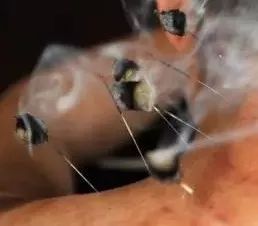 Warming Moxibustion DeviceThe warming moxibustion device is a method of moxibustion using specialized equipment for moxibustion treatment. When using a warming moxibustion device, moxa wool is placed inside the device and ignited, then the device is moved back and forth over the acupuncture point or treatment area until the area turns red. Due to the variety of warming moxibustion devices, it is impossible to introduce them all; here, only two commonly used types are introduced.(1) Warming Moxibustion Box: The warming moxibustion box is a commonly seen moxibustion device on the market, available in square and rectangular shapes of various sizes. During moxibustion, a lit moxa stick or moxa segment is placed on the iron mesh inside the box and covered, or the moxa stick is inserted into a hole in the box lid. It is important to ensure that the lit moxa stick is aligned with the acupuncture point, with each session lasting 15-30 minutes, and multiple points can be treated at once.This method is often applied to the waist, back, and abdominal acupuncture points, commonly used for treating stomach pain, gastric prolapse, diarrhea, coronary heart disease, urinary retention, acute mastitis, cervical spondylosis, sciatica, and stiff neck.(2) Warming Moxibustion Tube: Common warming moxibustion tubes come in cylindrical and conical shapes, with the cylindrical type suitable for larger treatment areas and the conical type often used for small area point moxibustion. The bottom of the warming moxibustion tube has dozens of small holes, and a small tube inside can hold moxa wool. During moxibustion, the moxa wool is ignited, and the tube is rolled or held stationary over the treatment area. Generally, moxibustion lasts for 15-30 minutes.This method is widely used, mainly for treating wind-cold-damp bi syndrome, abdominal pain, diarrhea, abdominal distension, and atrophy syndrome.Moxibustion Techniques1. Mastering the “Quantity” of Moxibustion(1) “Zhuang”: In ancient times, the counting unit for moxibustion was called “zhuang,” meaning that each time a moxa cone is burned, it is referred to as “one zhuang.” Generally, the larger the moxa cone, the greater the stimulation; the more zhuang used, the greater the stimulation. Typically, each acupuncture point is treated with 3-7 zhuang.(2) Distance of Moxibustion: Pure moxa stick moxibustion is generally performed at a distance of 2-3 cm from the skin, to avoid causing burning pain. Generally, the greater the distance, the smaller the stimulation.(3) Duration of Moxibustion: The duration is 10-15 minutes. Generally, the longer the time, the greater the stimulation.2. The Order of Moxibustion is ImportantGenerally, the upper part is treated first, followed by the lower part; yang areas are treated first, followed by yin areas; the number of zhuang starts small and increases; the size of moxa cones starts small and increases. However, in special circumstances, strict adherence is not necessary, and adjustments can be made as needed.3. The Key to Moxibustion is Achieving Qi Arrival for EffectivenessResearch shows that the sensation of transmission activity is a manifestation of the flow of qi in the meridians and a sign that the body’s endogenous regulatory function has been activated. The effectiveness of moxibustion is closely related to the degree of sensation transmission; the more pronounced the sensation, the better the effect. Using methods to stimulate sensation transmission and promote qi arrival at the disease site can yield unexpected results in moxibustion treatment and disease prevention.4. Selecting Acupuncture Points Accurately, Ensuring Sufficient HeatWhen selecting acupuncture points for moxibustion, it is important to be precise, using one to three points. Modern acupuncture scholars advocate: “Select points accurately, simplify needle use, do not use too many moxibustion points, ensure sufficient heat and even qi.”5. Seasonal MoxibustionSeasonal moxibustion refers to moxibustion performed at the nodes of seasonal transitions, especially during the transition from spring to summer and from summer to autumn, which is beneficial. At this time, the meridians open and close, and qi and blood circulate; timely moxibustion with the warming power of moxa can assist in the mutual generation of yin and yang, invigorate qi and blood, and enhance the effectiveness of disease treatment and prevention.In addition to seasonal moxibustion, moxibustion can be performed throughout the year, 365 days a year. The prohibitions mentioned in ancient texts regarding moxibustion during thunderstorms, rainy days, windy days, snowy days, and full moons are no longer considered taboos; moxibustion can also be effective in abnormal weather conditions.Furthermore, moxibustion can be performed during the day, but it is best to avoid it after 9 PM, except in emergencies.6. Contraindications for Moxibustion
Warming Moxibustion DeviceThe warming moxibustion device is a method of moxibustion using specialized equipment for moxibustion treatment. When using a warming moxibustion device, moxa wool is placed inside the device and ignited, then the device is moved back and forth over the acupuncture point or treatment area until the area turns red. Due to the variety of warming moxibustion devices, it is impossible to introduce them all; here, only two commonly used types are introduced.(1) Warming Moxibustion Box: The warming moxibustion box is a commonly seen moxibustion device on the market, available in square and rectangular shapes of various sizes. During moxibustion, a lit moxa stick or moxa segment is placed on the iron mesh inside the box and covered, or the moxa stick is inserted into a hole in the box lid. It is important to ensure that the lit moxa stick is aligned with the acupuncture point, with each session lasting 15-30 minutes, and multiple points can be treated at once.This method is often applied to the waist, back, and abdominal acupuncture points, commonly used for treating stomach pain, gastric prolapse, diarrhea, coronary heart disease, urinary retention, acute mastitis, cervical spondylosis, sciatica, and stiff neck.(2) Warming Moxibustion Tube: Common warming moxibustion tubes come in cylindrical and conical shapes, with the cylindrical type suitable for larger treatment areas and the conical type often used for small area point moxibustion. The bottom of the warming moxibustion tube has dozens of small holes, and a small tube inside can hold moxa wool. During moxibustion, the moxa wool is ignited, and the tube is rolled or held stationary over the treatment area. Generally, moxibustion lasts for 15-30 minutes.This method is widely used, mainly for treating wind-cold-damp bi syndrome, abdominal pain, diarrhea, abdominal distension, and atrophy syndrome.Moxibustion Techniques1. Mastering the “Quantity” of Moxibustion(1) “Zhuang”: In ancient times, the counting unit for moxibustion was called “zhuang,” meaning that each time a moxa cone is burned, it is referred to as “one zhuang.” Generally, the larger the moxa cone, the greater the stimulation; the more zhuang used, the greater the stimulation. Typically, each acupuncture point is treated with 3-7 zhuang.(2) Distance of Moxibustion: Pure moxa stick moxibustion is generally performed at a distance of 2-3 cm from the skin, to avoid causing burning pain. Generally, the greater the distance, the smaller the stimulation.(3) Duration of Moxibustion: The duration is 10-15 minutes. Generally, the longer the time, the greater the stimulation.2. The Order of Moxibustion is ImportantGenerally, the upper part is treated first, followed by the lower part; yang areas are treated first, followed by yin areas; the number of zhuang starts small and increases; the size of moxa cones starts small and increases. However, in special circumstances, strict adherence is not necessary, and adjustments can be made as needed.3. The Key to Moxibustion is Achieving Qi Arrival for EffectivenessResearch shows that the sensation of transmission activity is a manifestation of the flow of qi in the meridians and a sign that the body’s endogenous regulatory function has been activated. The effectiveness of moxibustion is closely related to the degree of sensation transmission; the more pronounced the sensation, the better the effect. Using methods to stimulate sensation transmission and promote qi arrival at the disease site can yield unexpected results in moxibustion treatment and disease prevention.4. Selecting Acupuncture Points Accurately, Ensuring Sufficient HeatWhen selecting acupuncture points for moxibustion, it is important to be precise, using one to three points. Modern acupuncture scholars advocate: “Select points accurately, simplify needle use, do not use too many moxibustion points, ensure sufficient heat and even qi.”5. Seasonal MoxibustionSeasonal moxibustion refers to moxibustion performed at the nodes of seasonal transitions, especially during the transition from spring to summer and from summer to autumn, which is beneficial. At this time, the meridians open and close, and qi and blood circulate; timely moxibustion with the warming power of moxa can assist in the mutual generation of yin and yang, invigorate qi and blood, and enhance the effectiveness of disease treatment and prevention.In addition to seasonal moxibustion, moxibustion can be performed throughout the year, 365 days a year. The prohibitions mentioned in ancient texts regarding moxibustion during thunderstorms, rainy days, windy days, snowy days, and full moons are no longer considered taboos; moxibustion can also be effective in abnormal weather conditions.Furthermore, moxibustion can be performed during the day, but it is best to avoid it after 9 PM, except in emergencies.6. Contraindications for Moxibustion
-
The facial area, precordial area, major blood vessels, and joints should not use scar moxibustion.
-
Pregnant women should avoid scar moxibustion on the lumbar and lower abdominal areas.
-
Patients with exogenous heat diseases, yin deficiency with internal heat, insufficient yin fluids, and excessive pathogenic heat should generally avoid moxibustion.
-
Patients who are overly fatigued, overly full, overly hungry, extremely thirsty, extremely frightened, or extremely angry should avoid moxibustion.
-
Patients with rapid heart rates or severe heart disease should only undergo moxibustion under the guidance of a professional doctor and should not perform it independently.
-
Infants and young children should be treated with caution to prevent burns, and some infants and young children may have sufficient yang energy, making excessive moxibustion likely to cause internal heat.
7. Post-Moxibustion CareAfter moxibustion, if the local skin appears slightly red and warm, this is a normal phenomenon and does not require treatment. If excessive moxibustion or prolonged duration leads to small blisters, as long as they are not broken, they can be left to absorb naturally. If the blisters are larger, they can be pricked with a sterilized needle to release the fluid, and then disinfected with gentian violet. Areas prone to friction can be protected with dressings.If using suppurative moxibustion, during the suppuration period of the moxibustion sore, it is important to rest appropriately, enhance nutrition, maintain local cleanliness, and change dressings in a timely manner to prevent contamination, allowing for natural healing. If not handled properly, if the pus from the moxibustion sore is yellow-green or there is bleeding, anti-inflammatory ointments or Yuhong ointment can be applied.For those who experience internal heat after moxibustion, it is advisable to reduce the amount of moxibustion, drink warm water, ensure adequate sleep, and exercise. Mild cases may resolve on their own. In severe cases, bloodletting at the ear apex or Dazhui point may be performed. Consulting a TCM practitioner for yin-nourishing and heat-clearing herbal medicine is also recommended, generally showing effects within two to three days.8. Attention to Smoke and Fire Safety
Moxa smoke can kill bacteria, and a small amount of inhalation is beneficial to the body, with no harm. However, long-term inhalation of large amounts of moxa smoke can cause some damage to the lungs. Therefore, attention should be paid to smoke ventilation during moxibustion.
Moxa wool is not easy to extinguish and can easily reignite; sometimes it may seem extinguished with water, but there may still be a small ember inside the moxa cone or stick that can slowly reignite and cause a fire. Therefore, after using moxa cones or sticks, ensure they are completely extinguished and can be placed in a sealed glass jar or metal box to ensure they do not reignite in an oxygen-free sealed space.
☞☞ Join the [Beauty Industry Practitioners WeChat Group] to exchange and learn with beauty professionals nationwide! Please click here
